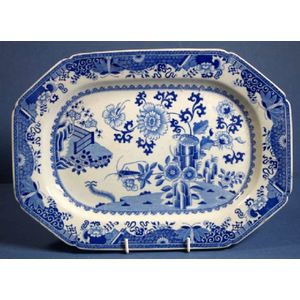Blue and White Victorian Earthenware Drainer
Victorian blue and white earthenware drainer blue and white Willow Pattern decoration, unmarked, length 31 cm
You must be a subscriber, and be logged in to view price and dealer details.
Subscribe Now to view actual auction price for this item
When you subscribe, you have the option of setting the currency in which to display prices to $Au, $US, $NZ or Stg.
This item has been sold, and the description, image and price are for reference purposes only.
- Victorian Period - The Victorian period of furniture and decorative arts design covers the reign of Queen Victoria from 1837 to 1901. There was not one dominant style of furniture in the Victorian period. Designers used and modified many historical styles such as Gothic, Tudor, Elizabethan, English Rococo, Neoclassical and others, although use of some styles, such as English Rococo and Gothic tended to dominate the furniture manufacture of the period.
The Victorian period was preceded by the Regency and William IV periods, and followed by the Edwardian period, named for Edward VII (1841 ? 1910) who was King of the United Kingdom and the British Dominions and Emperor of India for the brief period from 1901 until his death in 1910. - Earthenware - A basic ceramic material that is fired at a low temperature. Earthenware is the basis of almost all ancient, medieval, Middle Eastern and European painted ceramics. After firing, the colour is the colour of the clay when it is dug from the ground: buff, brown and red. It is not waterproof until glazed. Creamware is a type of earthenware covered with a transparent lead glaze. Majolica, faience and delft are also earthenware covered in an opaque white tin glaze.
- Willow Pattern - Although several potteries including Minton and Spode claim credit for design of the Willow pattern, the design is generally attributed to Thomas Turner of Caughley Porcelain Works in Shropshire, about 1780.
Whilst borrowing from the Chinese style, it was not a copy of a Chinese pattern.
The blue-and-white chinaware on which it appeared became immensely popular and the design was reproduced with variations by many English and European factories including Royal Worcester, Spode, Adams, Wedgwood, Davenport, Clews, Leeds and Swansea.
It was even copied in Asia, where it is still produced, with the wares being exported to Western countries.
The pattern portrays the garden of a rich mandarin whose young daughter elopes with his secretary. The lovers, overtaken on the bridge by her father, are transformed by the gods into birds and flutter beyond his reach. The scene with its willow tree usually covers the central part of a plate, dish, or bowl, with a border of butterflies, a fret, or other motif.
Traditional Willow pattern is in cobalt blue on white, though very occasionally other colours are used, such as purple or brown. The main part of the object contains the trees, houses, bridge, figures, and birds of the story and there is usually a fairly abstract pattern around the extremities.
This item has been included into following indexes:
Visually similar items

Spode blue and white 'Old Willow' drainer, with factory mark to base, width 34 cm
Sold by
in
for
You can display prices in $Au, $US, $NZ or Stg.

Georgian blue and white strainer, made by John Turner c.1785
Sold by
in
for
You can display prices in $Au, $US, $NZ or Stg.

Spode blue and white 'Grasshopper' hexagonal platter, stone china, factory mark to base, width 31.5 cm
Sold by
in
for
You can display prices in $Au, $US, $NZ or Stg.

Chinese export blue and white platter, early 19th century
Sold by
in
for
You can display prices in $Au, $US, $NZ or Stg.
